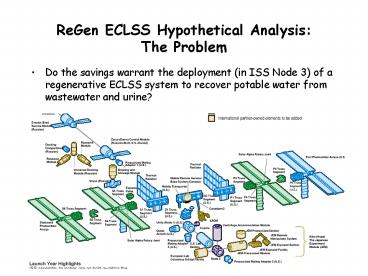ReGen ECLSS Hypothetical Analysis: The Problem
1 / 15
Title:
ReGen ECLSS Hypothetical Analysis: The Problem
Description:
Equipment dependent, 80.5% WRR from John Halligan, VIPER, for WPA, UPA, and SRV-K ... John Halligan, VIPER. Shadow prices from SDTM. ReGen ECLSS Hypothetical ... – PowerPoint PPT presentation
Number of Views:28
Avg rating:3.0/5.0
Title: ReGen ECLSS Hypothetical Analysis: The Problem
1
ReGen ECLSS Hypothetical AnalysisThe Problem
- Do the savings warrant the deployment (in ISS
Node 3) of a regenerative ECLSS system to recover
potable water from wastewater and urine?
2
ReGen ECLSS Hypothetical Analysis Essential
Elements of Analysis
- Annual logistics burden
- Cost of ReGen ECLSS spares ()
- Cost of ReGen ECLSS repairs ()
- Crewtime (hrs)
- Spares upmass (kg)
- Scenario characteristics
- Time horizon
- Crew size (total potable water requirements (kg))
- Partner capabilities to deliver potable water
- STS flights
- Pre- and post- ReGen ECLSS water recovery rates
- Initial investment cost
- Discount rate
f(system technical and RAM characteristics)
g(system technical characteristics)
3
(No Transcript)
4
ReGen ECLSS Hypothetical AnalysisThe Costs
MESSOC Results with WPA, UPA
Shadow prices from SDTM
Crew scenario dependent, 7-person crew results
from John Halligan, VIPER
Equipment dependent, 80.5 WRR from John
Halligan, VIPER, for WPA, UPA, and SRV-K
5
ReGen ECLSS Hypothetical AnalysisThe Benefits
4 Progress, 2 HTV, and 1 ATV flts/yr
Shadow price from SDTM
6
ReGen ECLSS Hypothetical AnalysisThe Breakeven
Point
7
MESSOC Overview
- An operations cost and performance estimating
tool for ISS using both high-level Station
configuration and operations scenarios, and
detailed design, logistics, and operations
characteristics - MESSOCs equations and algorithms estimate the
cost and performance through causal relationships - MESSOC can compare alternative scenarios and
design characteristics to inform program
decisions (trade studies)
Space 2000 American Institute of Aeronautics and
Astronautics
8
MESSOC 3.0 Architecture
User inputs and commands through Excel and Excel
VBA
Graphical User Interface
User Inputs
Update Engineering Data
Scenario Inputs
Scenario Outputs
Relational Datatables
Analytic Engine (Algorithms)
Algorithms in Excel VBA
Engineering Inputs
Datatables in Excel
9
Conceptual View of MESSOCAlgorithms
10
ReGen ECLSS Hypothetical AnalysisThe Shadow
Prices
- SDTM and shadow prices for Space Station
documented in - Chamberlain, R.G., Fox, G. and Duquette, W. A
Design Optimization Process for Space Station
Freedom, JPL Pub 90-23, June 1990 - NASA Code MSR Memo 90-082, Standard Life-Cycle
Cost Management Assumptions, September 17, 1990 - JPL Systems Office, SDTM Station Description,
Version 1.3, October 1990 - Shishko, R. Calculating Space Station Resource
Prices, AIAA-2000-0129, Space 2000 Symposium - Updated estimates to FY98 and more realistic STS
marginal cost per flight
11
Some Primary On-Orbit Resources
- IVA (Crewhours)
- EVA (Crewhours)
- Pressurized Upmass (kg)
- Unpressurized Upmass (kg)
- Internal Rack Accommodations (rack-hours)
- Power (kWh)
- Communications (kb)
- Robotics (robot-hours)
Space 2000 American Institute of Aeronautics and
Astronautics
12
Calculating Resource Shadow Prices
Min X
subject to
for i 1, . . . , N
N Number of resources Xi Gross supply of
resource i, Xi ? 0 Aij(Xj) Amount of resource
i used to produce Xj of resource j Ui Desired
user amount of resource i C(X) Present value of
future costs
Space 2000 American Institute of Aeronautics and
Astronautics
13
Calculating Resource Shadow Prices
Min X
From MESSOC
subject to
for i 1, . . . , N
N Number of resources Xi Gross supply of
resource i, Xi ? 0 Aij(Xj) Amount of resource
i used to produce Xj of resource j Ui Desired
user amount of resource i C(X) Present value of
future costs
Space 2000 American Institute of Aeronautics and
Astronautics
14
Calculating Resource Shadow Prices (continued)
Ci(Xi) Marginal direct cost for resource i
Hij(Xj) Marginal cross-consumption of
resource i used to produce Xj of resource
j pj Shadow price for resource j
From MESSOC for logistics resources
Space 2000 American Institute of Aeronautics and
Astronautics
15
ReGen ECLSS Hypothetical AnalysisIssues
- Sensitivity analysis wrt partner deliveries
- Shadow prices
- STS flights
- Remaining ReGen ECLSS investment costs































